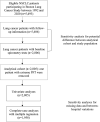Spirometry at diagnosis and overall survival in non-small cell lung cancer patients
- PMID: 35545892
- PMCID: PMC9761088
- DOI: 10.1002/cam4.4808
Spirometry at diagnosis and overall survival in non-small cell lung cancer patients
Abstract
Pulmonary function can predict all-cause mortality, and chronic obstructive pulmonary disease (COPD) is associated with worse overall survival (OS) in non-small cell lung cancer (NSCLC) patients. Though pre-operative lung function is predictive of in-hospital mortality following lung cancer surgery, its predictive utility for long-term survival is unclear. The prognostic role of commonly used spirometry tests in survival of lung cancer also remains uncertain. This study evaluates the role of spirometry at lung cancer diagnosis in predicting OS of NSCLC patients. This was a retrospective study using data from the Boston Lung Cancer Study on newly diagnosed NSCLC patients with spirometry tests performed before cancer therapy (n = 2805). Spirometric test values, after being categorized using quartiles, were analyzed for association with OS using univariate and risk-adjusted multiple regression models. Further, we analyzed OS by the status of COPD determined by spirometry, and, among those with COPD, by its stage defined by the Global Initiative for Chronic Obstructive Lung Disease criteria. Both univariate and multiple regression models demonstrated that lower quartiles of actual and percent predicted forced expiratory volume in 1 second and forced vital capacity at lung cancer diagnosis were significantly associated with worse OS. Spirometry-determined COPD, and more advanced stage of COPD at lung cancer diagnosis were associated with worse lung cancer OS. The findings provide evidence that a good pulmonary function at diagnosis may help improve OS in NSCLC patients.
Keywords: epidemiology; lung cancer; prognostic factor; survival.
© 2022 The Authors. Cancer Medicine published by John Wiley & Sons Ltd.
Conflict of interest statement
The authors have no conflict of interest to declare.
Figures



Similar articles
-
Comparison of clinical characteristics and overall survival between spirometrically diagnosed chronic obstructive pulmonary disease (COPD) and non-COPD never-smoking stage I-IV non-small cell lung cancer patients.Int J Chron Obstruct Pulmon Dis. 2019 May 1;14:929-938. doi: 10.2147/COPD.S190244. eCollection 2019. Int J Chron Obstruct Pulmon Dis. 2019. PMID: 31118602 Free PMC article.
-
Improved treatment outcome of pembrolizumab in patients with nonsmall cell lung cancer and chronic obstructive pulmonary disease.Int J Cancer. 2019 Nov 1;145(9):2433-2439. doi: 10.1002/ijc.32235. Epub 2019 Mar 25. Int J Cancer. 2019. PMID: 30807641
-
Impact of coexistent preserved ratio impaired spirometry on the survival of patients with lung cancer: Analysis of data from the Korean Association for Lung Cancer Registry.Thorac Cancer. 2021 Sep;12(18):2478-2486. doi: 10.1111/1759-7714.14095. Epub 2021 Aug 1. Thorac Cancer. 2021. PMID: 34337879 Free PMC article.
-
Chronic obstructive pulmonary disease with mild airflow limitation: current knowledge and proposal for future research - a consensus document from six scientific societies.Int J Chron Obstruct Pulmon Dis. 2017 Aug 29;12:2593-2610. doi: 10.2147/COPD.S132236. eCollection 2017. Int J Chron Obstruct Pulmon Dis. 2017. PMID: 28919728 Free PMC article. Review.
-
[Lung function test for COPD].Nihon Rinsho. 2003 Dec;61(12):2150-7. Nihon Rinsho. 2003. PMID: 14674325 Review. Japanese.
Cited by
-
Increased antioxidative defense and reduced advanced glycation end-product formation by metabolic adaptation in non-small-cell-lung-cancer patients.Nat Commun. 2025 Jun 3;16(1):5157. doi: 10.1038/s41467-025-60326-y. Nat Commun. 2025. PMID: 40461450 Free PMC article.
-
Data-Driven Personalized Care in Lung Cancer: Scoping Review and Clinical Recommendations on Performance Status and Activity Level of Patients With Lung Cancer Using Wearable Devices.JCO Clin Cancer Inform. 2023 Sep;7:e2300016. doi: 10.1200/CCI.23.00016. JCO Clin Cancer Inform. 2023. PMID: 37922433 Free PMC article.
-
Curative intent therapy of stage I-III non-small cell lung cancer: a patient-centered precision approach to assess, measure, and interpret benefits and harms.J Thorac Dis. 2025 Jul 31;17(7):4473-4500. doi: 10.21037/jtd-2025-213. Epub 2025 Jul 29. J Thorac Dis. 2025. PMID: 40809242 Free PMC article.
-
Impact of COPD pulmonary structural remodeling on the prognosis of patients with advanced lung squamous cell carcinoma.Heliyon. 2023 Nov 4;9(11):e22042. doi: 10.1016/j.heliyon.2023.e22042. eCollection 2023 Nov. Heliyon. 2023. PMID: 38027974 Free PMC article.
-
Respiratory Function as a Prognostic Factor for Lung Cancer in Screening and General Populations.Ann Am Thorac Soc. 2025 Apr;22(4):591-597. doi: 10.1513/AnnalsATS.202404-428OC. Ann Am Thorac Soc. 2025. PMID: 39589279
References
-
- Howlader N, Noone AM, Krapcho M, Miller D, Brest A, Yu M, Ruhl J, Tatalovich Z, Mariotto A, Lewis DR, Chen HS, Feuer EJ CK, (eds). SEER Cancer Statistics Review, 1975–2017. National Cancer Institute; 2020. Accessed November 6, 2021. https://seer.cancer.gov/csr/1975_2017/
-
- Brunelli A, Kim AW, Berger KI, Addrizzo‐Harris DJ. Physiologic evaluation of the patient with lung cancer being considered for resectional surgery: diagnosis and management of lung cancer, 3rd ed. American college of chest physicians evidence‐based clinical practice guidelines. Chest. 2013;143:e166S‐e190S. - PubMed
Publication types
MeSH terms
Grants and funding
LinkOut - more resources
Full Text Sources
Medical

